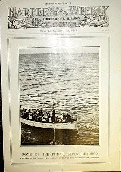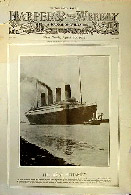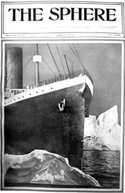An Introduction to Titanic in Magazines, by guest contributor Senan Molony.
There are many desirable Titanic magazines – making this a well-defined field, separate to the wider world of books on the subject.
 |
A steady demand has always been evident for the most prominent American magazine coverage of the disaster, which chiefly means relevant issues of Harper’s Weekly. Of course, there is a direct link here to the Titanic, because maiden voyage passenger Henry Sleeper Harper was a member of the family behind that publication.
H. S. Harper, with an eye to news value, related his story of the disaster to his own magazine. It was transmitted to readers through an interview by journalist William Inglis. Of course it was billed as "recorded exclusively for Harper's Weekly," but then Harper was never likely to tell his tale to any of his competitors. |
 |
This opus appears in the magazine supplement (part II) of the April 27 issue, entitled "The Titanic Disaster," and featuring a dramatic full-page picture of a lifeboat at the Carpathia's side. Inside are many similar photographs taken from the rescuing Cunarder, and there is a fine double-page spread of the sinking featuring the artwork of L. A. Shafer. This supplement also contains many photographs of the arrival of the ship bearing the survivors in New York.
|
 |
The front page of this April 27 issue, as distinct from the supplement, is entitled "Some of the Pitiful Seven Hundred" and is another full-page picture showing survivors in a lifeboat maneuvering to the side of the Carpathia in the early morning of April 15. |
 |
The April 20 issue, by contrast, came out before the survivors landed. Its front page shows "The Lost Titanic" with a photograph of the White Star liner as she left Southampton ten days previously. |
These two issues would typically go for $100 apiece. Coverage of the disaster in other US magazines, such as the Christian Herald or The Outlook is much more scant, without the news-value photographs that Harper's could boast, and therefore of less interest to serious collectors.
Many people might not be aware however that the real cream of Titanic magazine coverage lies on the other side of the Atlantic, in Britain, where the "yellow journalism" fad then in full flight in the United States was being counterpointed with a British obsession with excellence in production values.
This has bequeathed us a rich legacy of glossy magazines such as The Sphere, The Illustrated London News, and The Graphic, all of which were in their heyday just before the outbreak of the First World War.
 |
For this collector, The Sphere is the pick of the bunch, although all three combined high-quality paper with high-resolution web offset printing. This has allowed many of these magazines to survive in near pristine condition, frequently without the slightest yellowing. Thus the illustrations have the same drama and immediacy in the 21st Century that they were meant to convey to readers more than nine decades earlier. |
The sole exception is the April 20 special " In Memoriam" issue of The Graphic. This Titanic commemorative was printed on newsprint, a departure from the usual glossy paper, in order to achieve a mass printing to meet expected demand. The result was a journalistic feat in 1912, but this issue is now browned and brittle a century later. It is rare to find it in good condition. Nonetheless it frequently fetches a good price because it was a special commemorative, launched close to the disaster date.
At the other end of the scale, and not immediately Titanic-related, we find an issue of the Sphere from October 1910 that includes a seven page section on the launch of the Olympic. This issue is highly collectible and has sold at auction for £180.
The same stable's issue of April 27, 1912 comes with a scarce 12-page Titanic supplement. It is rare to find both together, and the supplement alone has sold for £130 at auction.
The best Sphere coverage is probably in its May 4 issue, which has an outer advertising cover and an inner frontispiece showing a wireless operator bent at his key, headphones on, frowning in concentration. This issue has 17 pages relating to the disaster.
A double page is filled with seven photos of survivors being picked up by the Carpathia. A double page (filled with captioned photos) tells of the postponement of the sailing of the Olympic the previous week. Another spread looks at the speed of big liners (with the aid of two large illustrations.) A graph analyses the deaths and survival rates from the various classes of passengers and crew.
There is a full-page photo of William Thomas Stead, founder and editor of the Review of Reviews, and a centerfold illustration of the ice field of the Atlantic. Photos and information about icebergs follow, and there is an aerial view of the Titanic's position in relation to many other ships drawn into the fringes of the disaster. Also of interest are facsimile wireless messages received by the Russian steamer Birma, and a panel of text filled with the words of Captain Moore of the Mount Temple telling of the C.Q.D. calls his ship received. Finally there is a page with illustrations of The Sphere's proposed detachable life raft for liners which could be fitted to a vessel's stern.
The May 11 issue has a Hichens frontispiece, showing the Titanic quartermaster gesturing to the Titanic model while giving evidence to the British Inquiry. Of sumptuous interest in this issue is the double-page spread 'Women and Children First’ by acclaimed Sphere artist Fortunino Matania (for more on this, see Encyclopedia Titanic research article: 'Anatomy of a Boat Deck Portrait). There is centerfold of lifeboats in the morning sun of April 15.
 |
Another Sphere supplement crops up two weeks later, dated May 25, 1912. The main magazine has a centerfold of what is claimed to be the iceberg that Titanic collided with. The supplement has its own description of "The World-Famous Iceberg Which Slew the Titanic." The front page tells how icebergs are formed and there is a sketch of the iceberg by seaman Joseph Scarrott, who described it as like the Rock of Gibraltar. |
Scarrott provided the information for a large sketch of the scene when the iceberg was seen, while various panels of text describe what happened that night. The back page has a large illustration of how water rose to E Deck and fell in a cascade to F deck. The full issue, without supplement was sold at auction for £75.
The Graphic.
 |
The April 20 'In Memoriam' number has already been described. The following week, April 27, 1912, sees a return to high-quality paper and contains eight pages of Titanic coverage. The frontispiece features 'The Last Call: Captain Smith's Final Order to The Crew of The Doomed Titanic,' drawn by Douglas Macpherson.' |
Articles include 'Swinging out a Lifeboat and Model of The Titanic's Welin and Collapsible Boats,' 'The Aftermath of The Titanic Disaster - The Reaction , The Lesson, The Investigation,' 'On Board The Olympic, Fitting the Titanic's Sister Ship with Collapsible Boats,' 'The American Investigator, Senator Smith,' 'The British Investigator, Lord Mersey,' 'White Star Chairman, Mr. Bruce Ismay, 'The Real Rescuer, Mr. G. Marconi, to whom, as the inventor of wireless telegraphy, the 705 survivors of the Titanic owe their lives,' and so on.
A full page concept of 'The End of the Titanic,' drawn by Henri Lanos has been reprinted many times in Titanic books. Another accomplished artist of the day, G. F. Morrell, illustrates 'The System of Bulkhead Compartments that Gave Way One by One.' There is a large picture of 'Mr. and Mrs. Sage who, with their Family of nine, have all been lost.' W. T. Stead is pictured again, this time in the office of The Review of Reviews, "which he edited so brilliantly."
When one thinks that single image Titanic postcards can go for $350 or more, it is strange that the treasure chests of fine illustrations contained in a single one of these magazines do not fetch more.
The Graphic also pictured the Rev John Harper - no relation to Henry Sleeper Harper, who was lost. He is shown with his little daughter and his niece. A photo also displays a famous item that went down with the vessel, the fabled jeweled Rubaiyat or 'Rich Omar Khayyam That Was Lost.'
One of the most reproduced images of the sinking, 'Titanic: Leaving The Sinking Liner: A Perilous Moment for The Lifeboats' was originally drawn by Charles Dixon RA for the Graphic. Similarly this magazine also carried a familiar image of a couple embracing while an officer appeals for entrants to a boat. This is officially titled 'The Rule of The Sea, Women and Children First: Final Farewells Between Wives and Husbands in the Sinking Titanic' and is drawn by Frank Dadd RA (Royal Academy).
The May 4 issue of this magazine has a full-page picture of stewards serving tea to survivors in the Carpathia. It boasts another rescue spread, showing lifeboats making their way to the ship, which has her gangway doors open. Again this is a familiar image, as is the full page illustration of passengers arriving in New York to be met by worried friends and relatives.
Coverage falls away sharply in this title thereafter, but the May 11 Graphic has portraits of Titanic officers and other witnesses drawn at the US Inquiry by one L. F. Grant, while the May 25 issue has a front page of Sir Cosmo Duff Gordon giving his evidence in London.
The Illustrated London News.
Oddly sought after is the issue of April 6, 1912 - the cover date being four days before the ship sailed! Why? because this is the issue that carries an advert for Vinolia Otto Toilet Soap, resplendent with a wave-slicing Titanic.
The April 20 issue has an iceberg like a sailing ship on the front, with pictures inside of the White Star office roof in Cockspur Street, London, flying the famous swallowtail flag at half mast. The magazine carries an illustration of a sailing vessel picking out an iceberg with a searchlight, and wonders whether such provision would have made a difference. There is also lavish coverage of the Titanic salons and appointments, with a wireless operator spread. This issue has 14 pages of Titanic coverage.
The April 27 issue of the ILN comes with a 12-page Titanic supplement in addition to eight interior pages of Titanic coverage. This particular double issue is very popular and has sold at auction for £150 in poor condition.
The May 4 Illustrated London News has a cover featuring J. Bruce Ismay at the US Inquiry. There is also a 'Landing in New York' spread, and one of boats approaching the Carpathia. Of news value is the coverage of the crew homecoming at Plymouth and the Olympic strike. This issue also features an illustration of stokers waiting patiently on the boat deck for the boats to be filled. It oddly appears as if it is raining! In this issue we also see the well-known image of Captain Smith swimming with a baby to a lifeboat page. The total number of disaster-related pages is an impressive 21.
Coverage collapses to about four pages in the May 11 issue, with only mini-portraits of the assessors at the British Titanic Inquiry, a page on the Jack Thayer drawings, and an illustration of the crow's nest. There is also material on new lifeboat inventions or improvements.
By May 18, Roald Amundsen is to the forefront, but in the May 25 issue there are three pages on British Inquiry witnesses, including those of the Californian, and material on the alleged bribery in lifeboat 1, with pictures of a Coutts cheque for £5, and pictures of Samuel Collins and Charles Hendrickson. There is a spread on Sir Cosmo Duff-Gordon, the cheque-issuer, testifying.
By June 1, there is only one page - showing where disaster met the Titanic, and including a classic image of body recovery by the Minia.
Some of these magazines provide more reading than a book. In many cases the illustrations are breathtaking and exquisite. They bring us back to a time and a place that send a shiver down the spine.
Any jaded Titanic bibliophile will find their palate quickly refreshed by such superb treats from the Titanic banquet.
- Senan Molony
|